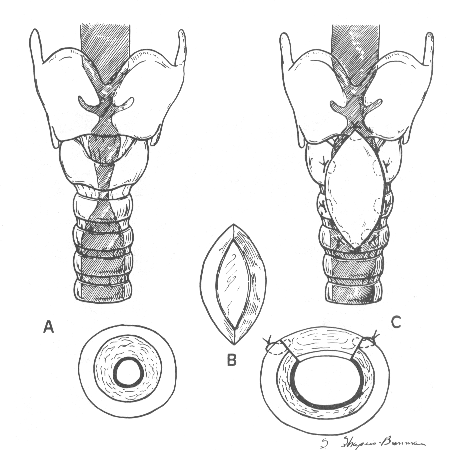Laryngotracheal Reconstruction
Laryngotracheal Reconstruction (LTR) is a surgical procedure to correct a narrowed airway.
There are several methods available for repair of the narrowed airway:
Two Stage: Widen the airway with placement of a rib cartilage graft and stent (plastic tube) to temporarily support the healing airway. The plastic tube is removed weeks later in the OR. Several additional scopes are usually required over several months until the trach tube is removed. The trach tube remains in place until the airway has healed.
Single Stage: Widen the airway with placement of a rib cartilage graft. The patient is kept sedated in the ICU for 7-14 days after the surgery with an endotracheal tube in place until the airway has healed.
Cricotracheal Resection: Removal of the narrowed airway segment.

A. Narrowed airway. B. Thyroid Ala or Rib Graft is harvested, carved and molded, the airway is then entered. C. The graft is then placed, widening the airway
Benefits:
- Provides a stable, open airway for breathing.
- Eventual removal of tracheostomy tube.
Risks of LTR:
During the operation
- Low blood oxygen
- Air Leak into chest cavity
- Bleeding
- Nerve Damage
- Dislodgement of the stent
After the operation
- Air Leak under the skin or into tissues
- near incisions
- Infection
- Displacement of the graft
Later Complications:
- Poor voice
- Tracheocutaneous fistula
- Problems with swallowing
- Recurrence of scarring and narrow airway
Complications of a single stage LTR:
- Obstruction of the endotracheal tube
- Unplanned exubation
- Difficulty with sedation
- Narcotic withdrawal
The most common serious complication of all methods of LTR is are narrowing of the airway, requiring revision of the LTR.
Single stage LTR requires a long hospitalization with prolonged paralysis and sedation. Two stage LTR has a shorter initial hospitalization but requires longer follow up. The physician will discuss all of the advantages and disadvantages of each type of surgery. A final decision is made based on the child’s medical condition, parent input, physician recommendation, age of child and child’s personality and temperament.
